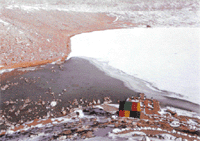SIKKIM Identity crisis
 Kanchendzonga, or the "five big treasures of ice' in the language of the Bhotia tribe of Sikkim, is the symbol of Sikkim's cultural identity, which is closely linked to nature. It is also venerated by Buddhists as the home of their presiding deity. It is also the source of nourishment for Teesta, perhaps the wildest river in the Himalaya, and one of the main sources of water supply in Sikkim.
Kanchendzonga, or the "five big treasures of ice' in the language of the Bhotia tribe of Sikkim, is the symbol of Sikkim's cultural identity, which is closely linked to nature. It is also venerated by Buddhists as the home of their presiding deity. It is also the source of nourishment for Teesta, perhaps the wildest river in the Himalaya, and one of the main sources of water supply in Sikkim.
Placed in a geologically-sensitive zone, Sikkim is prone to landslides. Geologists fear that an increase in glacial meltwater will only add to the problems. "Sikkim is dotted with glacial lakes, so an increased volume of meltwater can lead to sudden glacial lake outbursts and devastating floods and landslides,' says P Mukherjee, deputy director, Geological Survey of India, Gangtok.
Most glaciers in Sikkim originate from the Kanchendzonga. The Rangit, which is the largest tributary of the Teesta, is mainly fed by the Rathong Chu and the Prek Chu in northwest Sikkim. And Teesta gets its nourishment from the Onglokthang glacier. "The Rathong and the Onglokthang glaciers are receding rapidly,' says G P Chattopadhyaya, glaciologist and geographer, department of geography, Presidency College, Calcutta, who was part of a team of environmentalists and scientists that conducted a detailed study of the Kanchendzonga National Park area from Dzongri to the glaciers, in May 1995.
The team found that, since the Little Ice Age, the Onglakthong glacier had retreated by about 500m and the Rathong glacier by about 600m. Sikkim's largest glacier, Zemu, had retreated by about 3-4 km.
"If glaciers continue to recede, it will spell disaster for Sikkim's fragile ecology and result in the premature death of the Teesta after a period of devastating floods,' says Chattopadhya. Mahendra Lama of the School of International Studies, Jawaharlal Nehru University, adds "Geologists suspect that the overflooding of the Teesta River in October 1968 was also due to a glacial lake outburst.'
But Eklabya Sharma, principal scientist at the G B Pant Institute of Himalayan Development, Gangtok, Sikkim refuses to share the pessimism. "What we need is more weather monitoring stations. Most of the current predictions are based on isolated studies. They are useful but cannot be the sole yardstick,' he says.
